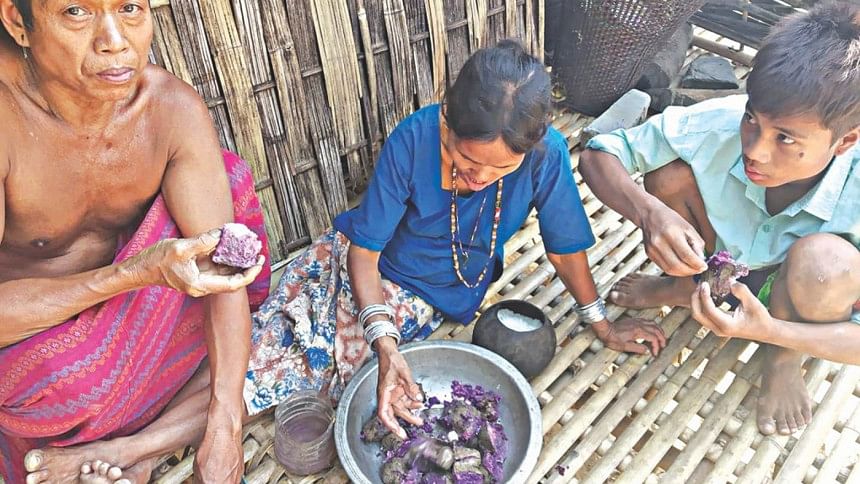Still left behind: Covid-19 and indigenous peoples of Bangladesh

As we witnessed the global crisis of the coronavirus pandemic hit Bangladesh at the end of March 2020, we became anxious about the impact it would have on the indigenous peoples of the country, who were already struggling with longstanding issues related to their socioeconomic, political and cultural rights.
There are over 50 indigenous communities living in Bangladesh, primarily spread in the delta region of the country or "the plains", as well as in the south-eastern part of the country known as Chittagong Hill Tracts (CHT). These diverse communities have their distinct languages, cultures and heritage and only constitute approximately 1-2 percent of the total population of the country. As minorities, the indigenous peoples have long been cut off from the benefits of mainstream socio-economic development measures. A recent study by Bangladesh Institute of Development Studies and ILO revealed that several socioeconomic indicators such as health, education, household-level income, food consumption, participation and women's empowerment remain below the national average for indigenous peoples.
For instance, the poverty rate among indigenous peoples is much higher than the national average of 20.5 percent. The poverty rate among the indigenous peoples in the plains is nearly 80 percent whereas, in the CHT, it is around 65 percent. The indigenous population of the country has been living in a state of perpetual marginalisation and poverty due to various factors. Their lives and livelihoods have become highly vulnerable due to the increasing dispossession of land and resources caused by conflict, land grabbing, climate change and various development interventions, as well as the prevailing systemic discrimination.
Soon after the government declared a country-wide shutdown to prevent the spread of Covid-19, the immediate socioeconomic impacts of the pandemic hit the indigenous communities the hardest. According to a recent study we conducted on the impact of the pandemic on indigenous communities, thousands of ready-made garment workers and beauty parlour workers have lost their jobs, agricultural production has been hampered, small enterprises are struggling to survive, regular health services and education facilities have been disrupted, violation of indigenous peoples' human rights has been on the rise and, most alarmingly, indigenous communities are faced with a severe food insecurity. For example, the Hajong families in Durgapur, Netrokona reported having to cut down on the number of meals eaten per day to only one. Many indigenous migrant workers who have returned home are now staying at their village without any income and are in desperate need of employment opportunities for their survival.
What is noteworthy is that the communities seem to be more anxious about the impact of the shutdown rather than the spread of the virus. As one of the respondents, Kalu Ram Rishi, a 42-year-old Mushor labourer from Parbatipur, Dinajpur said, "The indigenous Mushor community is more afraid of starvation during the lockdown period than being affected by the virus."
The government has taken several policy measures in response to the Covid-19 crisis, including social safety net and other support programmes for the low-income and marginalised groups. However, most indigenous communities involved in our study have reported that they received little or no support from these programmes.
The government's initiative of remote learning through digital education (i.e. classes broadcasted through Sangsad TV and YouTube) remains inaccessible to hundreds of thousands of marginalised indigenous students due to the existing "digital divide". On top of the existing challenges to accessing education such as language barrier, indigenous children both in the hills and plains lack adequate IT equipment, internet connection, and sometimes even electricity.
The International Monetary Fund has projected that Bangladesh's economic growth, which has been steady at 7 percent a year on average over the past decade, is likely to drop to 2 percent in 2020. As an unofficial lockdown continues with no timeline in sight, indigenous peoples who are already facing multiple difficulties engendered by the Covid-19 crisis are now confronted with even graver challenges in the days to come.
As we celebrate this year's International Day of the World's Indigenous Peoples with the theme "COVID-19 and indigenous peoples' resilience", we observe with indignation that the indigenous peoples of the country continue to be disproportionately impacted by the crisis. While the indigenous communities have been demonstrating incredible resilience at the face of historical injustices and marginalisation, let us not forget that the responsibility for protecting them still lies with the state.
Therefore, it is crucial for the government of Bangladesh to explicitly address the needs and priorities of the indigenous peoples not only in terms of short-term responses to the pandemic, but also in terms of the prevailing systemic and structural socio-political, economic and cultural barriers that continue to marginalise them.
Trimita Chakma is an independent feminist researcher and activist, and a member of Kapaeeng Foundation. Pallab Chakma is the Executive Director of Kapaeeng Foundation.

 For all latest news, follow The Daily Star's Google News channel.
For all latest news, follow The Daily Star's Google News channel. 



Comments